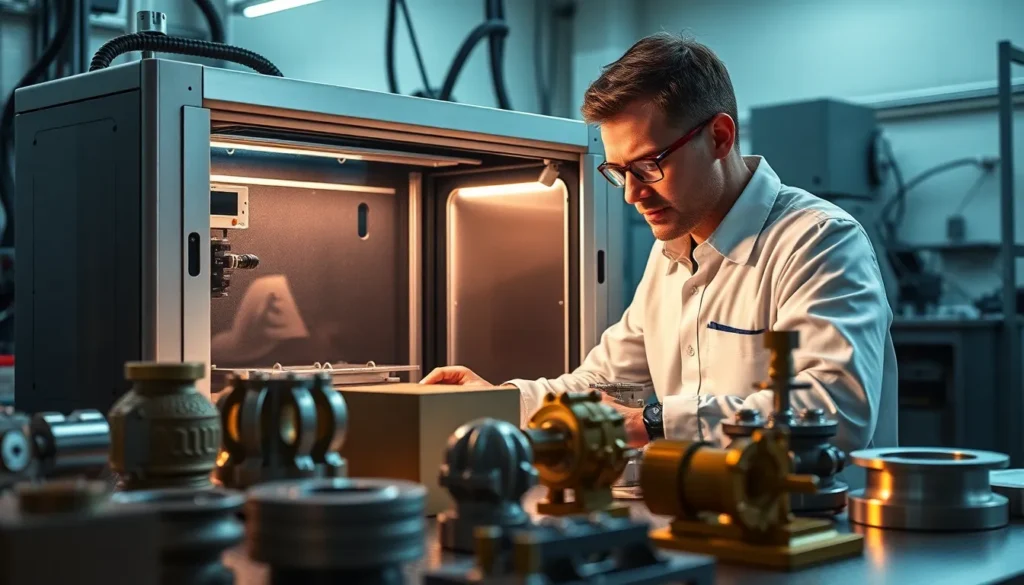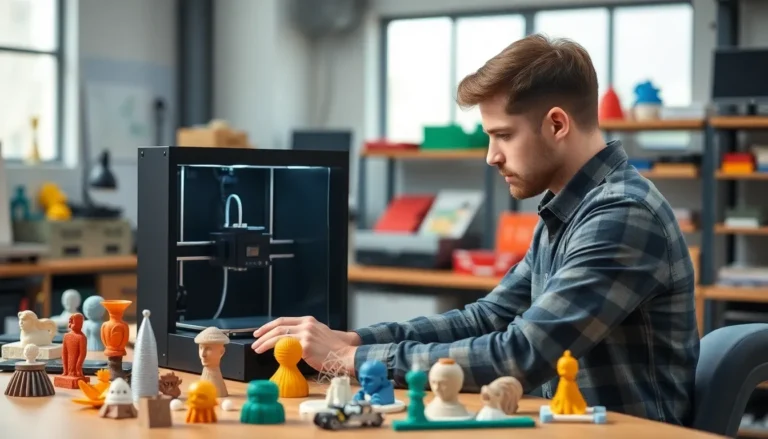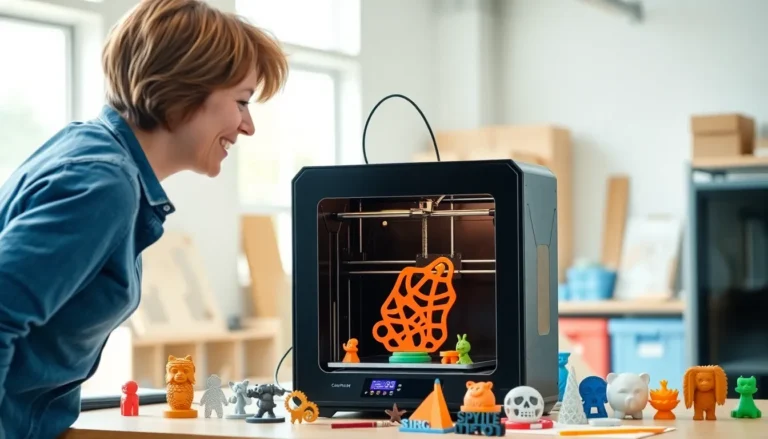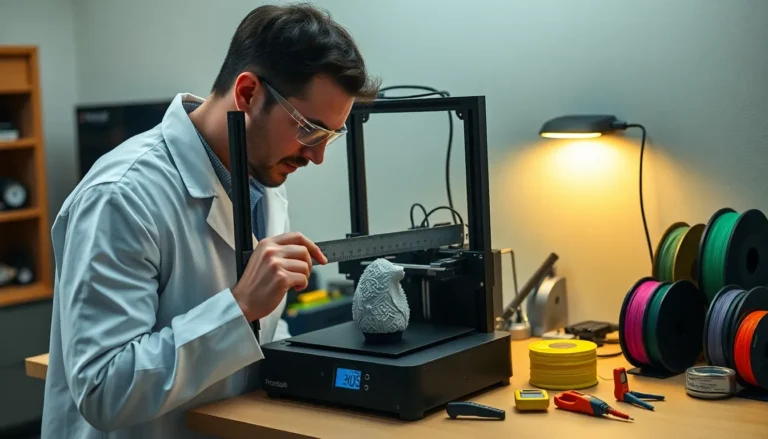In a world where everything seems to be going digital, SLM 3D printing is the superhero we didn’t know we needed. Imagine turning a pile of metal powder into intricate parts faster than you can say “additive manufacturing.” This technology isn’t just a passing trend; it’s reshaping industries from aerospace to healthcare and making engineers feel like wizards in lab coats.
Table of Contents
ToggleOverview of SLM 3D Printing
SLM 3D printing stands as a revolutionary method for fabricating metal components. This technique uses laser technology to fuse metal powder layer by layer, creating intricate designs efficiently.
What Is SLM 3D Printing?
SLM, or Selective Laser Melting, refers to a metal additive manufacturing process that melts and fuses metallic powders. By utilizing high-powered lasers, a three-dimensional object forms from a digital model. This approach differs from traditional manufacturing, enabling the production of complex geometries that conventional methods struggle to achieve. Metal types like titanium, aluminum, and steel commonly undergo transformation through this process.
Key Features and Benefits
Key features of SLM 3D printing include precision, material efficiency, and design flexibility. This technology allows intricate designs that reduce material waste while enhancing structural integrity. Speeding up the production cycle significantly benefits industries that require rapid prototyping and customization. Additionally, SLM enables manufacturing of lightweight components imperative in aerospace and automotive applications. The ability to produce near-net-shape parts minimizes post-processing needs, further streamlining production.
Applications of SLM 3D Printing
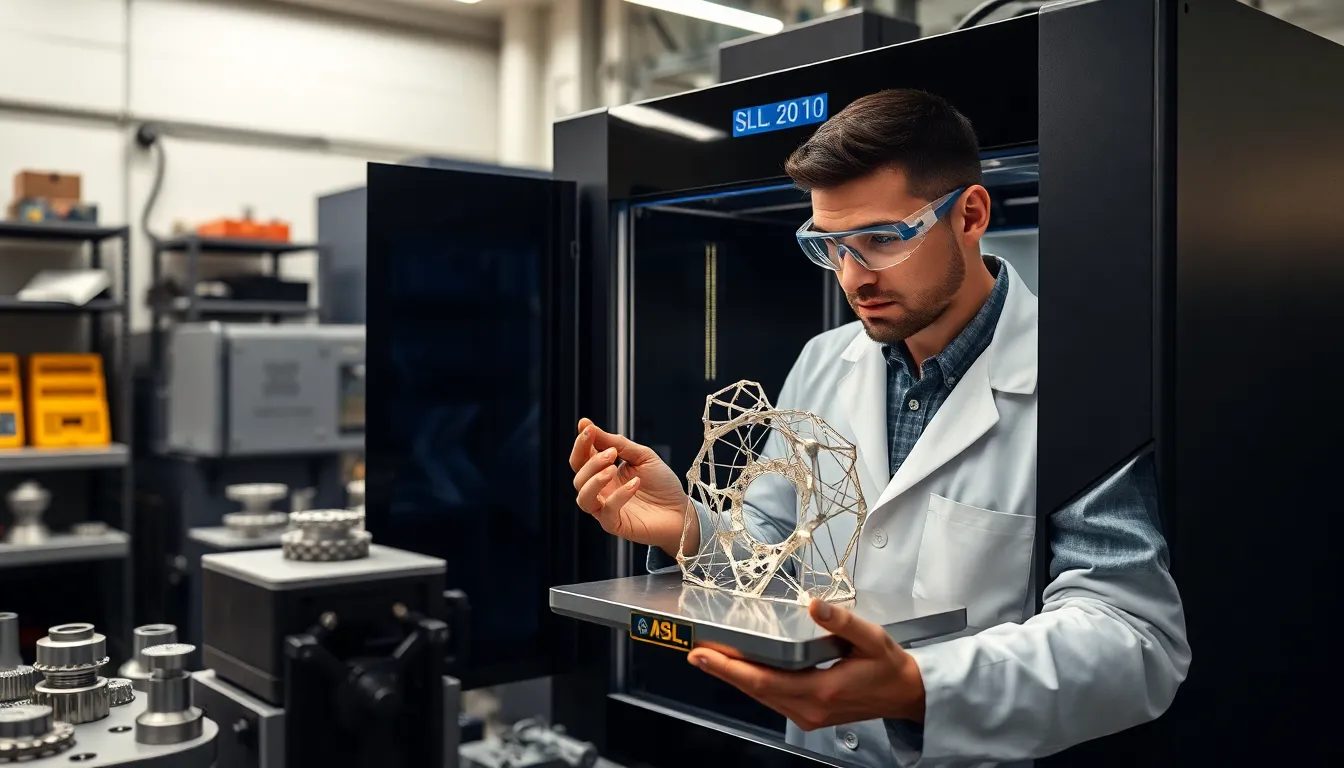
SLM 3D printing revolutionizes various industries by enabling the rapid and precise production of complex metal components. Its applications span fields such as aerospace, healthcare, and automotive.
Aerospace Industry
SLM 3D printing plays a crucial role in aerospace manufacturing. This technology enables the fabrication of lightweight components that reduce weight without compromising strength. Complex geometries lead to improved fuel efficiency in aircraft. Components like engine parts and structural elements benefit from the design flexibility offered by SLM. Manufacturers utilize materials such as titanium and aluminum for their high strength-to-weight ratios. As a result, production cycles shorten, and costs often decrease.
Medical Field
Within the medical field, SLM 3D printing addresses the need for customized medical devices. Prosthetics and implants can be produced with specific geometries tailored to individual patients. Biocompatible materials ensure that implants integrate seamlessly with human tissue. Surgeons rely on precise models created with SLM for surgical planning and education. The technology significantly reduces production lead times, allowing for rapid prototyping of vital components like surgical tools and orthopedic implants. Consequently, patient care improves through enhanced device performance and customization.
Automotive Sector
In the automotive sector, SLM 3D printing transforms the production of parts and tools. Manufacturers leverage this technology to create intricate designs that are often impossible with conventional methods. Weight reductions in components contribute to better fuel economy and performance. SLM facilitates rapid prototyping, allowing for quicker iterations in design and development. Tools, brackets, and replacement parts benefit from the precision and material efficiency offered by SLM. Innovations in this sector can lead to significant cost savings and shorter time to market for new vehicles.
Comparison with Other 3D Printing Technologies
SLM 3D printing stands out against other technologies, particularly FDM and SLA, offering unique advantages and features.
FDM vs. SLM
Fused Deposition Modeling (FDM) utilizes thermoplastic filaments, whereas SLM employs metal powders. Precision remains a hallmark of SLM, allowing for complex geometries unattainable with FDM. Production time differs significantly; SLM typically completes parts faster for intricate designs. Material strength varies as well; components produced through SLM show superior mechanical properties compared to FDM’s output. Industries requiring lightweight and durable components favor SLM over FDM, especially in aerospace and automotive sectors.
SLA vs. SLM
Stereolithography (SLA) relies on resin curing using UV light, while SLM focuses on laser melting metal powders. SLM excels at creating functional metal parts, while SLA often produces high-detail prototypes or models. Material choices differ significantly; SLM uses various metals, enhancing durability, while SLA primarily offers plastics. Post-processing requirements vary between the two technologies—SLM parts often need minimal finishing compared to SLA’s. For applications demanding robust and intricate metal components, SLM provides clear advantages over SLA technology.
Challenges in SLM 3D Printing
SLM 3D printing faces several challenges that can impact its effectiveness and adoption in various fields.
Material Limitations
Material limitations pose significant challenges in SLM 3D printing. Specific metal powders are required, and these materials can be expensive and limited in availability. Titanium and aluminum are popular choices, but not all alloys perform well under SLM processes. The requirement for high-quality powder also means strict control over particle size and distribution must occur. Poor powder quality can lead to defects in the finished product, undermining the precision of the technology. Understanding these constraints is essential for selecting appropriate materials that align with desired performance characteristics.
Cost Considerations
Cost considerations significantly affect the adoption of SLM 3D printing. The initial investment for SLM equipment remains high, making it less accessible for small businesses. Operational costs also increase due to expensive metal powders and the need for skilled operators. Economies of scale can be challenging, especially for low-volume production runs, where the per-part cost becomes prohibitively high. While the technology offers benefits such as reduced waste and shorter production times, initial and ongoing expenses can deter some organizations from integrating SLM into their manufacturing processes.
Future Trends in SLM 3D Printing
SLM 3D printing continues to evolve, bringing significant innovations that will shape its future and transform various industries.
Innovations on the Horizon
Emerging technologies in SLM 3D printing focus on increasing build speeds and improving powder recycling processes. Advancements in multi-laser systems significantly reduce production times while enhancing overall efficiency. New alloy compositions and blends expand material capabilities, allowing for improved performance in demanding applications. Software innovations streamline print preparation and quality assurance, ensuring consistency and reducing errors. Additionally, integration with artificial intelligence leads to smarter process monitoring and control, enabling real-time adjustments during printing.
Market Growth Predictions
Predictions for SLM 3D printing indicate substantial market growth over the next five years. Analysts anticipate a market size increase from approximately $3 billion in 2023 to over $7 billion by 2030. Industries, including aerospace, automotive, and healthcare, will drive this growth as they adopt SLM technology for its capability to produce complex parts and reduce material waste. Increased investment in research and development fuels further advancements, enhancing competitiveness. Moreover, the demand for customized products and rapid prototyping prompts widespread integration of SLM technologies across various sectors.
SLM 3D printing stands at the forefront of manufacturing innovation. Its ability to create complex metal parts with precision and efficiency is reshaping industries like aerospace and healthcare. As engineers embrace this technology, they’re unlocking new possibilities for design and production.
While challenges such as material costs and equipment investments exist, ongoing advancements promise to enhance SLM’s capabilities. The future looks bright with innovations in build speeds and material compositions on the horizon. As adoption increases, SLM 3D printing is set to play a pivotal role in the evolution of manufacturing, driving growth and efficiency across various sectors.

